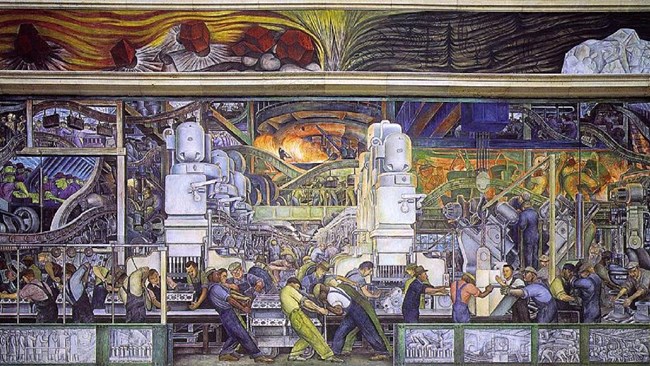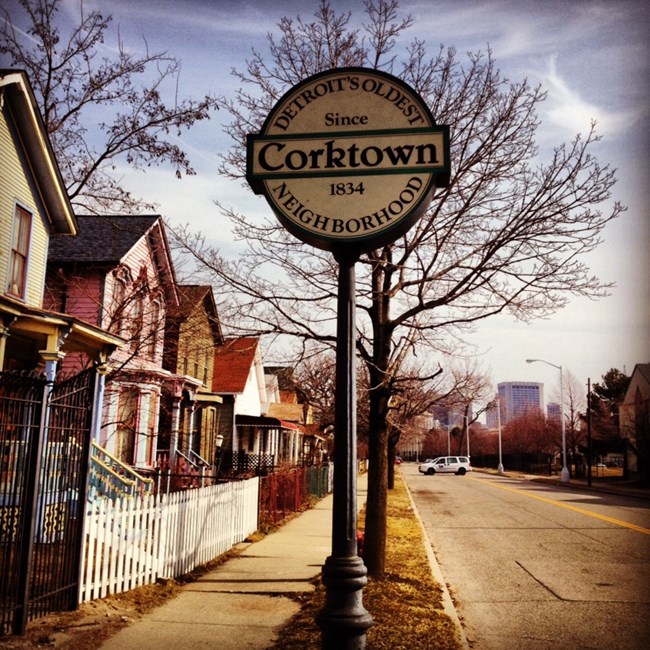Part of a series of articles titled Curiosity Kit: Detroit's Labor History .
Previous: Places of Labor History in Detroit
Article

Public Domain, https://commons.wikimedia.org/w/index.php?curid=17023625
This Curiosity Kit Educational Resource was created by Katie McCarthy a NCPE intern with the Cultural Resources Office of Interpretation and Education.
The city of Detroit’s history is closely tied with industrial growth and labor history. The city’s location on the Great Lakes made it an important transportation hub for the Midwest. Major companies such as the Parke-Davis Company, Globe Tobacco, and Ford Motor Company established headquarters and factories there. These companies provided jobs for thousands of people, including women, immigrants, and African Americans throughout the 1900s. You can learn more about the Detroit and the people who worked there by visiting the Places of Labor History in Detroit.
Compare Detroit’s labor history with the history of your community.
Understand the impact of industry on a community.
Learn about your community’s cultural, industrial, and immigration histories.
Analyze a variety of primary sources, including artwork, oral histories, newspaper articles, and community documents.
What forces shape a community? What has shaped your community’s history?

Between 1932 and 1933, Mexican artist Diego Rivera painted four murals consisting of 27 panels at the Detroit Institute of Art. Rivera represented the workers of Detroit, including those at the Ford factory. These murals are now a National Historic Landmark, and you can learn more about them on the National Park Service’s website. Using Rivera’s murals for inspiration, it is your turn to draw a mural of your community. As you brainstorm, consider the following questions:
What are the famous landmarks in your community?
What are the gathering spaces in your community?
Is there one type of job that many of the people in your community do, or do community members have many different jobs?
How can you celebrate the culture and history of your community in your mural? Is there anyone you’d like to commemorate in your mural?
What kind of message do you want to share with your mural? How can that message be shared through color and symbols in your artwork?
From farming to pharmaceuticals, all communities have some form of labor history. Here is a chance to learn yours! Research your community’s labor history by exploring local or national newspaper archives, local historical societies, and community oral histories. Labor history is a broad category. It includes industrial labor like in Detroit but also many different forms of work such as farming, teaching, office work, and grocery store workers. Anywhere people work, there is labor history! As you do so, consider the following questions:
What were the first major companies in your area? Are they still there? Have they been replaced by other industries?
Who did they hire to work in their farms, factories, or offices? Has this changed over time?
Has there ever been strikes or boycotts of these companies in your community? What caused them? How were they resolved?
How did historical events like the Great Depression or World War II impact these industries?
How does this industry or company tie your community to other communities?

Detroit is home to the Corktown Historic District. Corktown was originally established by Irish immigrants in the 1830s. In the early 1900s, the neighborhood became home to immigrants from Malta. Later, in the 1920s it became a bustling Latinx community. These waves of immigration give Corktown a rich history. Many communities across the United States have been shaped by generations of immigration. Using digital sources, your local historical society, and community oral histories or conversations with community members, research the history of where people in your town or community have come from. You may also choose to research the history of another town or location. As you do so, consider the following questions:
What countries (or other states) did people travel from? Has this changed over time?
What Indigenous people lived in this area before immigrants settled there?
What reasons did people have for immigrating to your area?
What types of jobs did they do prior to moving? What types of jobs did they do after they immigrated?
What challenges did/do immigrants face in their new communities?
How has the history of immigration shaped your community?
Part of a series of articles titled Curiosity Kit: Detroit's Labor History .
Previous: Places of Labor History in Detroit
Last updated: May 4, 2021